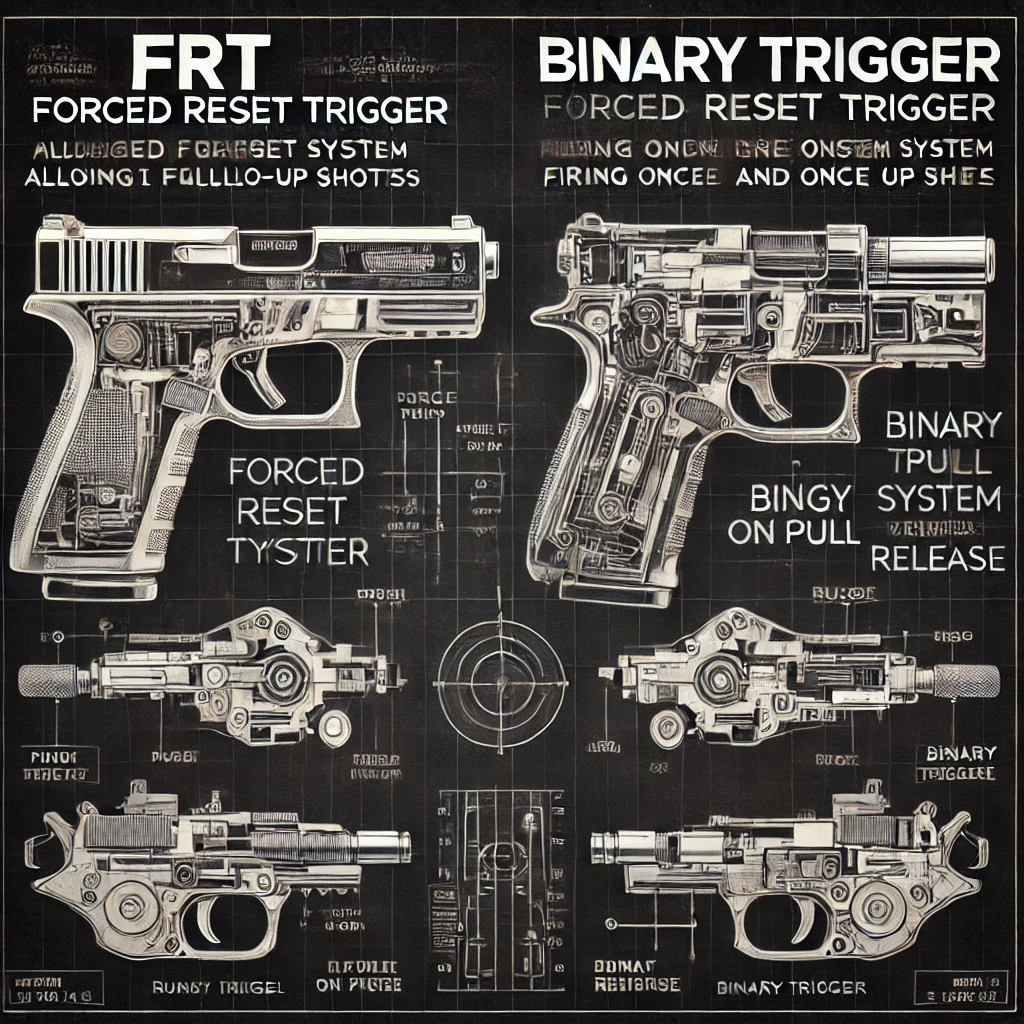When it comes to upgrading your firearm’s performance, the trigger plays a significant role. Two popular choices among gun enthusiasts are Forced Reset Triggers (FRT) and Binary Triggers. Each of these triggers offers a unique mechanism and performance, catering to specific shooting needs and preferences. But which one is best for you? Let’s break down the features, functionalities, and legal considerations to help guide your decision.
Understanding the FRT Trigger Mechanism
Forced Reset Triggers, commonly referred to as FRTs, are designed to enhance the firing rate of semi-automatic firearms. This mechanism doesn’t convert your firearm into a fully automatic device but allows for rapid, controlled shooting. It’s a favorite among competitive and recreational shooters who prioritize precision and speed in their firearm performance.
How the FRT Mechanism Works
The key to the FRT’s operation lies in its forced reset system. After firing a shot, the trigger is mechanically reset by a spring-assisted mechanism. This rapid reset eliminates the delay or “trigger lag” between shots, allowing for faster follow-up shots.
Picture this in action: you fire a round, and as soon as the trigger is pulled, it’s already being pushed forward in preparation for your next shot. This means you’re not manually waiting for the trigger to reset—it’s instantaneous. This feature is particularly useful for shooters competing in timed events or practicing scenarios that require quick target acquisition.
Notably, FRTs maintain the firearm’s semi-automatic classification, provided they are used correctly and without any additional modifications that could compromise their legal status. This unique balance of speed and precision makes the FRT a top choice for individuals seeking optimal firing rates without crossing into fully automatic territory.
How Binary Triggers Function
Binary triggers, on the other hand, take a different approach to increasing firing speed. This type of trigger allows you to fire one round when you pull the trigger and another round when you release it. Effectively, this doubles the rate of fire compared to traditional semi-automatic triggers.
Key Features of Binary Triggers
Binary triggers are unique because they introduce a dual-action firing system. Here’s what distinguishes them:
- Fires on Both Pull and Release: This dual-action mechanism gives the feel of increased firepower while keeping it semi-automatic.
- Higher Rate of Fire: By doubling the rate of fire, binary triggers provide a distinct edge in rapid shooting situations.
- Specialized Trigger Assembly: Binary triggers require an upgraded trigger system and specific installation procedures to function correctly.
While binary triggers improve firing speed, they require extra care to handle properly. Overuse or improper handling can lead to reduced stability or recoil control, which may impact accuracy.
Comparing FRT and Binary Triggers: Key Differences
Though both types of triggers aim to enhance firearm performance, they differ significantly in their mechanisms and practical use. Below is a side-by-side comparison:
| Feature | FRT Trigger | Binary Trigger |
| Firing Mechanism | Forced reset with mechanical assistance | Fires on both pull and release |
| Rate of Fire | Higher than standard but not full-auto | Faster due to dual-action firing |
| Legal Considerations | Subject to ATF scrutiny | Requires careful legal compliance |
| Best Use Case | Competitive shooting, rapid follow-ups | Tactical and recreational shooting |
Which Trigger is More Effective?
The effectiveness of an FRT or a binary trigger ultimately depends on your specific needs as a shooter. Competitive shooters and those focusing on precision performance may lean toward FRTs. Alternatively, individuals seeking higher rates of fire for tactical or recreational shooting might find binary triggers to be the better choice. Either way, understanding your firearm habits and goals will help you make a more informed decision.

Legal Aspects and ATF Regulations
Both forced reset and binary triggers are closely monitored by the Bureau of Alcohol, Tobacco, Firearms, and Explosives (ATF). While these triggers are marketed as enhancing semi-automatic firearms without converting them to fully automatic, certain models have faced heightened regulatory scrutiny.
Under the National Firearms Act (NFA), these triggers are technically legal when used as intended. However, misuse or unauthorized modifications can result in your firearm being reclassified as fully automatic—leading to legal trouble. Always double-check federal laws and consult an experienced gunsmith if you’re unsure about compliance.
State-Specific Laws on Triggers
It’s crucial to keep in mind that trigger regulations vary from state to state. For instance, some states prohibit the sale or installation of binary triggers entirely. Others may have restrictions on FRTs. Researching your state’s specific laws before making a purchase is essential to avoid any legal complications.
Advantages of Using an FRT Trigger
What makes the FRT trigger stand out from its binary counterpart? Here are its most notable advantages:
- Enhanced Speed Without Full-Auto Conversion: While you enjoy a faster firing rate, your gun maintains its semi-automatic classification when used correctly.
- Smoother Trigger Operation: FRT mechanisms allow for a smoother trigger pull, which often contributes to better accuracy and precision shooting.
- Competitive Edge: These triggers are a top choice for individuals participating in shooting sports, as they allow for quick, controlled bursts of fire.
Why Shooters Prefer FRT Triggers
Reliability is the number one reason gun enthusiasts gravitate toward FRTs. The spring-assisted reset mechanism ensures repetitive precision, making it more enjoyable and effective during competitions or practice sessions.
Advantages of Binary Triggers
Binary triggers come with their own set of benefits, most of which focus on speed:
- Enhanced Firepower: The pull-and-release system gives you double the firing rate without legally converting your firearm to a fully automatic weapon.
- Unique Shooting Experience: Many shooters find the binary trigger adds a fun and dynamic element to firearm use, especially in tactical and recreational settings.
Situations Where Binary Triggers Excel
Binary triggers shine in scenarios where rapid successive shots are needed. Whether you’re practicing for self-defense or enjoying a fast-paced shooting range experience, these triggers provide a boost in performance.
Performance Testing: Accuracy and Rate of Fire
Triggers like FRTs and binary models aim to bridge the gap between semi-automatic functionality and the rapid firepower of automatic firearms. But how do they compare in terms of accuracy and rate of fire?
Measured Performance Results
Performance tests and user experiences reveal that FRT triggers consistently offer better control and recoil management, which leads to more accurate follow-up shots. Binary triggers, while improving firing speed, often demand more advanced handling skills due to potential impacts on recoil stability.
If you wanted to get more consultation about it, visit our website FRT Trigger.
Best Firearms Compatible with FRT and Binary Triggers
Not all firearms are compatible with these advanced trigger types, but several models stand out as ideal platforms:
- AR-15: The AR-15 is versatile and serves as an excellent host for both FRT and binary triggers.
- Glock 17: Select aftermarket binary trigger models can be installed in Glock 17 handguns, enhancing their capabilities.
- AK-47: Some trigger manufacturers offer aftermarket options specifically designed for AK-47 rifles.
How to Choose the Right Firearm
Your choice of firearm should depend heavily on your intended use. For tactical scenarios, AR-15 rifles with binary triggers may suit you best. Conversely, an FRT-equipped firearm may be ideal for competitive settings.
Safety Considerations When Using High-Performance Triggers
It’s important to prioritize safety when handling high-performance triggers. Increased firing rates can pose new challenges, even for experienced shooters.
Training Tips for Safe Use
Regular practice is essential to ensure you remain in full control of your firearm. Training with mock scenarios or at the range can improve your ability to handle increased firing speeds safely. Additionally:
- Always confirm the firing pin and hammer are in perfect working condition.
- Regularly engage the safety lever when the firearm is not in use to prevent accidental discharges.
Installation Guide: How to Install an FRT or Binary Trigger
Installing either trigger type requires attention to detail. Follow these general steps:
- Unload Your Firearm: Ensure the gun is completely unloaded and safe to handle.
- Remove the Stock Trigger Assembly: Disassemble the manufacturer’s factory trigger mechanism carefully.
- Follow Manufacturer Instructions: Each trigger system will come with specific installation guidelines. Adhere to them for optimal performance.
- Test Thoroughly: Before heading to the range, empty-test your firearm to ensure the trigger operates as expected.
Common Installation Mistakes to Avoid
Installing these triggers incorrectly can lead to malfunctions, which compromise both safety and performance. Take care when adjusting springs and housing components to avoid misalignment.
Comparing Semi-Automatic and Fully Automatic Firearms
A common misconception is that FRTs or binary triggers convert semi-automatic firearms into full-auto ones. This isn’t true. What sets semi-automatic firearms apart is requiring a trigger pull for each shot.
Why Semi-Automatic Firearms Are Popular
Semi-automatic firearms strike a balance between firepower and control, making them versatile for various uses—whether it’s competition, self-defense, or recreation.

How Triggers Affect Shooting Sports and Competitions
Enhanced triggers like FRTs and binary systems are game-changers in competitions. They reduce split times between shots, providing a measurable advantage. Many organizations permit their use, provided regulations are followed.
Popular Competitions Where Triggers Matter
From 3-gun competitions to tactical shooting events, these triggers are commonly seen among competitors looking to maximize their performance.
Common Myths About FRT and Binary Triggers
Several myths persist around these triggers:
- Myth: These triggers turn firearms into machine guns.
Fact: They increase the rate of fire while maintaining semi-automatic functionality. - Myth: Using these triggers is always illegal.
Fact: While laws differ, they’re legal in many regions when installed and used correctly.
Debunking Misinformation
Educating yourself about these systems ensures that you make an informed decision and remain compliant with legal and safety measures.
Expert Recommendations for Firearm Enthusiasts
Experts advise selecting a trigger system based on your unique use case. For quick follow-up shooting in a competition, FRT triggers excel. If you prefer a more rapid fire experience, binary triggers are a better fit.
What Experts Say About These Triggers
Professional firearm trainers suggest extensive practice and responsible handling to maximize the potential of either trigger type safely.
Conclusion: Which Trigger is Right for You?
Choosing between an FRT and a binary trigger comes down to your priorities. Are you focused on precision and controlled shooting? Go with an FRT. Do you want to maximize firing speed for recreational or tactical purposes? A binary trigger might be your best bet. Above all, ensure you train regularly, comply with laws, and handle your firearm responsibly to get the most out of these advanced trigger systems.

